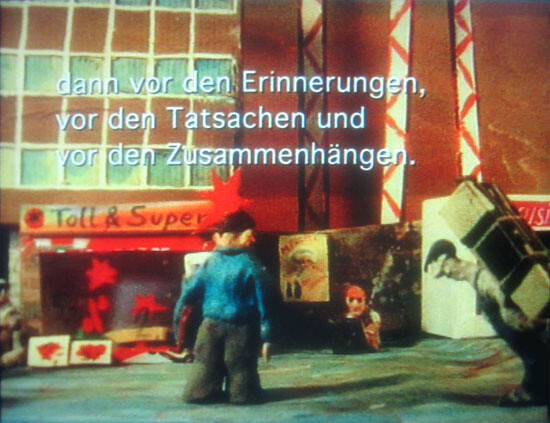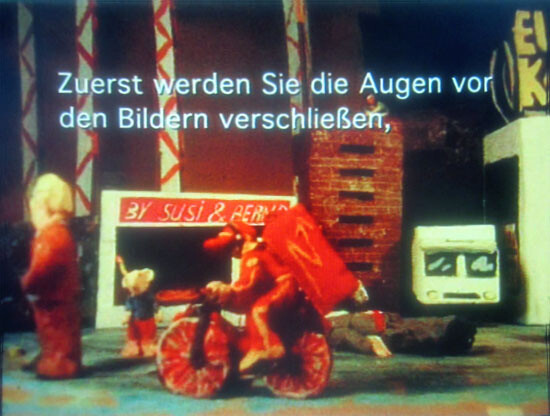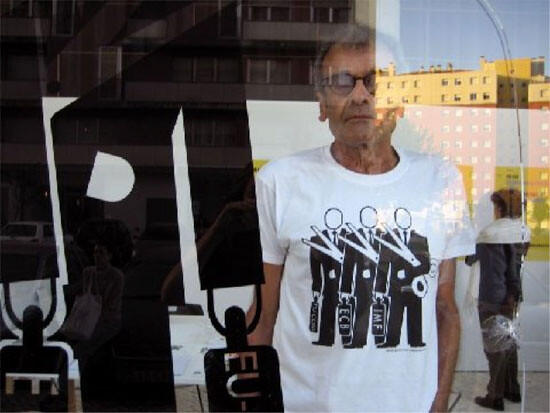We see a street through a surveillance camera. A crowd of working people are out and about—informants, money transporters, messengers, street cleaners, sausage vendors. Private and state security agents can be seen in the background, aiming at pedestrians from an enclosure. Now and again, a pedestrian is hit and falls to the ground. A house is raided by police officers. Another security agent poisons his own dog. A poem is superimposed over the scene:
Everything that doesn’t blind us is real.
How can we show you investments in action,
or the movements caused by capital—
the privileges, the dependencies, the dreams of elimination,
the capacity for betrayal in each and every one of us?
How can we show you capital flows in detail,
their source, course, and estuary pockets—
who is allowed to work for them, at what pay, and when they’re laid off?
But if we draft a picture of a machine
that simulates the market economy,
you will shut your eyes.
First you will shut your eyes to the pictures,
then to the memories,
then to the facts and correlations.
We can give you only a rough idea
of how the market economy works.
That’s from The Crooked Paw (Die Krumme Pranke, 1999), an animated film we shot with Amelie Wulffen and Josef Strau about the privatization of Berlin’s public spaces. We were witnessing this destruction on a daily basis—the everyday disenfranchisement and repression. In the meantime, a wave of neo-national ideologization was sweeping the country, particularly the art world. We perceived it as a new beginning.


Our street-scene poem plagiarizes a passage from Harun Farocki’s The Inextinguishable Fire (Nicht Löschbares Feuer, 1969), a film that deals with the impossibility of describing the effects of napalm. In a memorable scene, Farocki outlines the monstrous abyss between description and fact, in a manner both existential and banal, by putting out a cigarette on his arm.
How can we show you napalm in action?
And how can we show you the injuries caused by napalm?
If we show you pictures of napalm burns, you’ll close your eyes.
First you’ll close your eyes to the pictures.
Then you’ll close your eyes to the memory.
Then you’ll close your eyes to the facts.
Then you’ll close your eyes to the entire context …
We can give you only a hint of an idea of how napalm works.
—The Inextinguishable Fire
Along with Allan Sekula’s compositions, Harun Farocki’s work was one of the few tools we had at our disposal to decipher the political reality dawning on us at the outset of the ’90s. The forced euphoria of the neoliberal offensive seemed to be completely overturning reality—distorting countless artistic methods, corrupting them, making them useless or just ridiculous. Harun Farocki’s films retained their integrity, distance, and precision.
We met Farocki a few years after plagiarizing his film, to exchange a copy of The Crooked Paw for a copy of The Inextinguishable Fire. We found him to be very good-natured and generous. He didn’t take us very seriously, with our obsessively splenetic super-8 film—all plasticine animations, digitized and edited with friends on the first avid media composer.Our collaboration started later, when we discovered a shared admiration for Gerd Arntz and Otto Neurath’s pictorial statistic method of the 1920s. Arntz and Neurath’s goal—in conjunction with the Communist enlightenment of the people—was to represent political facts in quantifiable terms; not to show numbers and curves that would be immediately and visually graspable, but rather to force viewers to slow their reading and spend a certain time counting. This delay in comprehension, which makes the facts tough and hard to digest, always seemed to us closely related to Harun’s work. His film Between Two Wars (Zwischen Zwei Kriegen) features the journal Wirtschaftsformen (Economic Systems) from the Atlas der Gesellschaft und Wirtschaft (Atlas of Society and Economics), as well as Gerd Arntz’s graphics, which were an homage to the council revolutions of the 1920s and their occupation of factories and army bases. The immediate proximity of these graphics to that revolutionary society lent them a special aura. And we rediscovered this aura, fifty years later, in films like Between Two Wars and Inextinguishable Fire.


Harun, we assume, was often amused and a bit perturbed by our political naivety, which—fueled by the excitement of the moment—was often ignorant to previous experiences. Today, as is probably typical for those who are left behind, we find ourselves wishing that we’d spoken more with Harun, who seemed to us like a mighty, rather ironical resonance chamber for the history of political subjectification. We could have discussed our respective experiences of politicization, what that meant at different times—a conversation that only now, at the time of this writing, seems unfinished.
Instead, we will watch his films, which still break down the res gestae of image power with a precision and clarity second to none: camera images dispatched from bombs, the snow left by their impact, visual material that was used to justify declarations of war or to whistle-blow through WikiLeaks—material on the control of consumers, captives, candidates, soldiers, civilians, and again and again the transition from control to execution.
We last worked together on the project Labor in a Single Shot (Ein Einstellung zur Arbeit), which had Harun and Antje Ehmann travelling around the world for the past few years, setting up workshops in various cities, encouraging participants to capture their local labor situation from a cinematic perspective. We presented the cities’ data according to the pictorial statistical method of Arntz and Neurath, and designed a central icon for each location. The icon for Lisbon designed itself: three people—representing the IMF, the European Central Bank, and the European Commission—each holding scissors. Since the mass protests in Greece, Spain, and Portugal in 2011, this image has become a symbol for the execution of whole economies in accordance with the German model.
The destruction of public space through privatization, disenfranchisement, and repression that left us speechless in the ’90s is now an exported standard.
Too few artists today are developing the tools to measure this repression, to make it tangible and debatable. We’re missing people who give us—through their work—the means to despise this repression. The photo below shows Harun wearing the scissor-wielding trifecta on a T-shirt, after the Goethe Institute in Lisbon refused to print the icon on their press release.


Translated from the German by Leon Dische Becker.
Images copyright the authors.

